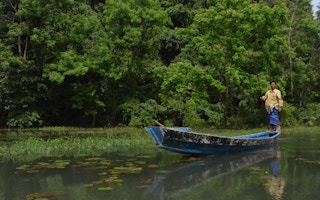Just days before the water fights were set to erupt across Chiang Rai for Songkran — Thailand’s New Year celebration, held every April and known for its festive street soakings — the city’s residents received a sobering warning: avoid contact with the Kok River, which winds through this northern Thai city of 200,000.
The reason? Tests conducted upstream had detected dangerous levels of arsenic and other hazardous substances.
The alarm had first been raised the previous month, when people living near and across the border in Myanmar, where the 285-kilometre (177-mile) Kok River originates, reported skin rashes after bathing, elephants showing signs of illness, and fish turning up dead in the water. Just as communities prepared to celebrate renewal and rebirth, their most important river was declared off-limits.
Since then, the situation has grown even more dire. Follow-up testing in both the Kok and the nearby Sai rivers has revealed widespread contamination, especially close to the Thai-Myanmar border. Most sampling sites have shown arsenic levels far above safety standards, and in some areas, the water has turned an unsettling orange-yellow hue.
Perhaps even more alarming, elevated arsenic levels have also been found in the Mekong River, which is fed by both the Kok and Sai rivers. Tests at two sampling points in the Mekong showed concentrations above safe limits, indicating the contamination may be spreading into Southeast Asia’s most vital waterway.
The elevated arsenic levels are widely seen as evidence of unregulated gold mining in Myanmar’s southern Shan state, where extraction has surged in recent years.
“
The current impacts are already clear: people can’t use the river for water, gardening, or cultural activities.
Phra Mahanikom, vice abbot, Wat Thaton temple
Arsenic occurs naturally in mineral-rich bedrock and is often released when gold-bearing ore is crushed during mining. Additional toxic chemicals, such as mercury and cyanide, are also used to extract gold and can further contaminate waterways. These pollutants leach into the headwaters of the Kok and Sai rivers, which both originate in Myanmar.
The region is politically volatile, with much of the mining taking place in territory controlled by ethnic armed groups, most prominently the United Wa State Army (UWSA), an ethnic Wa militia that’s widely regarded as a proxy for Chinese interests. Now, mounting evidence suggests that rare earth mining, arguably even more environmentally destructive and harder to regulate than gold mining, is also expanding across this lawless terrain.
Rare earth minerals, a group of 17 chemically similar elements, are critical components in everything from electric vehicles and wind turbines to smartphones and military equipment. With the rise of clean energy technologies, global demand for these minerals has soared, fueling a surge in mining, often in poorly governed regions.
Drone footage and satellite imagery have revealed new mining sites cropping up just across the border in Myanmar, pointing to a rapidly growing extractive industry operating with little to no oversight. “This is organised environmental crime,” says Pianporn “Pai” Deetes of International Rivers and one of the lead organisers campaigning against the contamination.
On June 5, some 1,500 people gathered in Chiang Rai to demand the closure of illegal mines in Myanmar. Protesters had pledged to deliver letters to Thailand’s prime minister, China’s president, the head of Myanmar’s military junta, and the president of the armed group believed to be behind the mining activity.
Many tied blue and green ribbons to the Kok River Bridge in a show of solidarity with the river and resistance to the transboundary pollution now threatening it. There were separate gatherings of Thai protesters on the Mekong River in Chiang Sean and upstream on the Kok River in Tha Ton.
On June 8, the Chinese embassy in Bangkok responded, via Facebook, saying China “attaches great importance to the incident of heavy metal contamination in tributaries of the Mekong River in Thailand” and calling for resolution through “friendly dialogue.”
Earlier in the year, smaller protests took place after residents along the Kok River in Chiang Mai province reported the river turning unusually cloudy. Several people developed persistent skin rashes after swimming, including a 45-year-old man in Mae Ai district, who told Thai PBS his rash lasted more than a month, far longer than usual. A 14-year-old boy in the same district also reported similar symptoms after entering the river.
Environmentalists and medical experts warn that the health and ecological risks are serious. Arsenic contamination poses significant danger if the water is consumed untreated, and it can also harm aquatic life, making fishing and water-based activities unsafe. Downstream of Chiang Rai city, a dam diverts river water for agricultural irrigation, raising fears that crops may also be at risk of contamination.
At a recent community meeting in Chiang Rai, one participant was Phra Mahanikom, a 60-year-old Buddhist monk and vice abbot at Wat Thaton temple in Mae Ai district. “The current impacts are already clear: people can’t use the river for water, gardening, or cultural activities,” he said.
It was early reports from communities like his that prompted regional authorities to begin water testing. Initial results showed turbidity levels 10 times above accepted limits and confirmed unsafe concentrations of lead and arsenic.
Penchom Saetang, executive director of the NGO Ecological Alert and Recovery–Thailand (EARTH), credited officials from the Chiang Mai office of Thailand’s Pollution Control Department for publicly releasing the results and warning residents. “Their transparency helped the public and media understand the seriousness of the issue and was key in raising awareness and prompting swift action,” she says.
At the national level, Thai officials have sought to project confidence. Deputy Prime Minister Prasert Jantararuangtong announced the creation of a local operations centre, led by the deputy interior minister, to coordinate the response. In recent days, authorities have tried to reassure the public, insisting that tap water remains safe and attributing red spots on fish to parasites and bacteria, not arsenic.
But environmental groups challenge those assurances, saying there’s no clear evidence the situation is improving. “I have zero confidence that the government has this under control,” Deetes says.
Environmental officials conducted a fourth round of water sampling between May 26 and 30, though results have yet to be released. Meanwhile, EARTH, which has also not yet released results, collected 66 environmental samples from 13 sites on the Kok and Sai rivers, including water, soil, sediment and agricultural produce such as rice, garlic and eggplant.
With the rainy season in its early stages, fears are growing that floods could spread contaminants even farther. Chiang Rai experienced some of its worst flooding in years last year, with large volumes of muddy runoff, believed to originate from mining areas, intensifying the damage.
Reports of unusual symptoms and fish abnormalities have been widespread. During a recent boat trip on the Mekong near Chiang Khong, a group of Laotian fishermen described catching fish with strange blisters and spots for months. They declined to give their names, fearing repercussions. “We’ve been cooking them, so it should be OK,” one fisher said.
For Thai authorities, confronting the crisis is proving deeply complicated. Myanmar’s junta has no control over most of Shan state, a region dominated by ethnic militias that operate with near-complete autonomy. There are no environmental guardrails, and no clear negotiating partner. “The Thai government doesn’t know who it should deal with,” says Suebsakun Kidnukor, a lecturer at Mae Fah Luang University and a leading voice in the environmental campaign.
Rare earth mining, long concentrated in Myanmar’s Kachin state to the north, now appears to be spreading south, bringing with it extensive deforestation and water pollution.
While mining in Shan state has historically targeted silver, lead, zinc and gemstones, new satellite imagery and drone footage suggest a shift. Thailand’s Geo-Informatics and Space Technology Development Agency (GISTDA) identified more than 40 new land-clearance sites near the Kok and Sai headwaters in the past two years, correlating with the period of rising turbidity and arsenic levels.
Unlike gold mining, rare earth extraction often occurs on hillsides, leaving behind visible scars and toxic chemical ponds. These operations use ammonium sulfate and other compounds to leach valuable minerals from the soil, often with devastating effects. “No one has studied the impact of rare earth mining on rivers [in Thailand],” Deetes says. “This is a new monster to us.”
Although China’s share of global rare earth extraction has dropped to around 70 per cent as other countries have entered the market, it still dominates processing and refining. Tighter environmental laws at home have driven Chinese firms to seek resources abroad, particularly in poorly regulated areas like Myanmar. The rare earth trade remains opaque, and enforcement of international environmental and sustainability standards is extremely weak.
Despite the lawlessness, the current climate in Shan state is relatively stable and it remains somewhat safe to do business there, says Ailey Zaulawt, a Myanmar-born researcher on conflict resolution and energy issues based in Chiang Rai. “The armed groups have no choice but to do this kind of business to fund their operations. I have no doubt that we will see many more mines. This is only the beginning of the story.”
The contamination’s expansion into the Mekong could have sweeping regional consequences. The Mekong River supports tens of millions of people’s livelihoods across Southeast Asia. The Mekong River Commission, an intergovernmental body established in Laos to manage shared resources, has warned of potential transboundary impacts reaching Laos, Cambodia and Vietnam.
For some, the crisis is spiritual. “The Buddha teaches us that the environment is sacred,” said Phra Mahanikom, the monk who spoke at the recent community meeting. “Nature is our creator. Forests, water and land are all connected. If Mother Nature is destroyed, we cannot live in peace.”
Others warn against despair. Niwat Roykaew, a Goldman Environmental Prize-winning activist involved in the campaign, says the path forward begins with changing how we value the river. “Mekong environmental problems won’t end as long as governments and people see only profit in its resources,” he says. “We need to value it for its natural worth. That’s the only way forward.”
He adds: “But we do have hope — and yes, we must stand up and fight.”
This story was published with permission from Mongabay.com.










